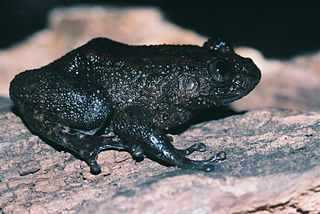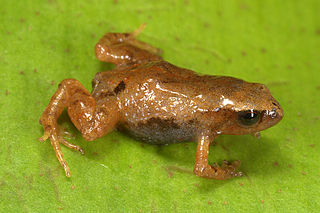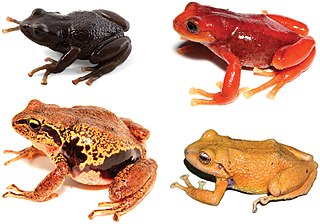Mount Duida frogs (Dischidodactylus), is a genus of craugastorid frogs endemic to the tepuis of southern Venezuela. The scientific name is derived from the Greek dischidos, meaning divided, and dactylos, meaning finger or toe, in reference to the divided ungual flap.

Nyctibatrachus is a genus of frogs endemic to the Western Ghats of southwestern India. Their common name is night frogs. Their scientific name also means "night frog", in reference to their habits and dark color. They are the only extant members of the monotypic subfamily Nyctibatrachinae. Currently, 35 species belong to Nyctibatrachus.

Tomopterna is a genus of frogs from sub-Saharan Africa.

Oreobates is a genus of frogs in the family Strabomantidae. Most species were formerly in the genus Ischnocnema, but were moved to this revalidated genus following a 2006 revision. Its sister taxon is Lynchius.

Craugastor is a large genus of frogs in the family Craugastoridae with 126 species. Its scientific names means brittle-belly, from the Ancient Greek krauros and gastēr.
Strabomantis anatipes is a species of frog in the family Strabomantidae. It is found in the Mira River drainage in extreme northern Ecuador and in adjacent southern Colombia in foothills and lower cloud forest on the Pacific lowlands and slopes of the Cordillera Occidental. It altitudinal range is 100–1,600 m (330–5,250 ft) asl.
Strabomantis anomalus is a species of frogs in the family Strabomantidae. It is found in the Chocoan rainforests from near sea level to elevations of 1,180 m (3,870 ft) in northwestern Ecuador and western Colombia.
Strabomantis necerus, also known as the Mindo robber frog or hornless groundfrog, is a species of frog in the family Strabomantidae. It is found on the lower Pacific slopes of the Andes from Cotopaxi Province northward to Carchi Province, Ecuador, and Valle del Cauca Department, Colombia.
Strabomantis cornutus is a species of frog in the family Strabomantidae. It is found along the eastern flank of the Andes of Ecuador and Colombia north to Caquetá Department. Common name Rio Suno robber frog has been coined for it. It has been confused with other species.

Phrynobatrachus is a genus of Sub-Saharan frogs that form the monogeneric family Phrynobatrachidae. Their common name is puddle frogs, dwarf puddle frogs, African puddle frogs, or African river frogs. The common name, puddle frog, refers to the fact that many species breed in temporary waterbodies such as puddles.

Incilius is genus of toads in the true toad family, Bufonidae. They are sometimes known as the Central American toads or Middle American toads and are found in southern USA, Mexico, Central America, and northern Pacific South America. They are an ecologically and biogeographically diverse group of toads, including micro-endemic species such as Incilius spiculatus that are restricted to undisturbed cloud forests, and widespread lowland species such as Incilius valliceps that predominantly occur in disturbed habitats.

Ameerega is a genus of poison dart frogs in the family Dendrobatidae. These frogs live around rocks that are nearby streams. They are found in central South America north to Panama. It contains many former species of the genus Epipedobates.

Pristimantis is a very large genus of frogs distributed in the southern Caribbean islands and in Central and South America from Honduras to northern Argentina and southern Brazil. With 596 described species, the genus had more species than any other genus of vertebrate animals. Many of these species genus are endemic to the Northwestern Andean montane forests ecoregion in north-western South America.

The Strabomantidae are a family of frogs native to South America. These frogs lack a free-living larval stage and hatch directly into miniature "froglets". This family includes Pristimantis, the most speciose genus of any vertebrate.

Craugastoridae, commonly known as fleshbelly frogs, is a family of New World direct-developing frogs. As delineated here, following the Amphibian Species of the World, it contains 129 species. They are found from the southern United States southwards to Central and South America.

Diasporus is a genus of frogs in the family Eleutherodactylidae. The genus was first described in 2008. They are found in Central and northern South America. They are sometimes referred to as dink frogs, in reference to the "tink" sound that males make during the mating season.

Lynchius is a genus of frogs in the family Strabomantidae. The name honours herpetologist John D. Lynch. The distribution of Lynchius is restricted to the Cordillera Oriental in southern Ecuador and Cordillera de Huancabamba in northern Peru.

Psychrophrynella is a genus of frogs in the family Strabomantidae The genus is distributed on the Andes of southern Peru and Bolivia. One of the four species assessed by the International Union for Conservation of Nature (IUCN) is assessed as "Critically Endangered".

Niceforonia is a genus of frogs in the family Strabomantidae found in northern South America. The name refers to Nicéforo María, Colombian herpetologist.

Ceuthomantis is a small genus of craugastorid frogs, also treated as comprising their own monogeneric family Ceuthomantidae. They are found in the southern and eastern parts of the Guiana Highlands in Venezuela, Guyana, and Brazil. The generic name is derived from the Greek noun mantis, which means treefrog, and adjective keuthos, which means hidden, in allusion to the hidden existence of this genus in the tepuis of the Guiana Shield.















